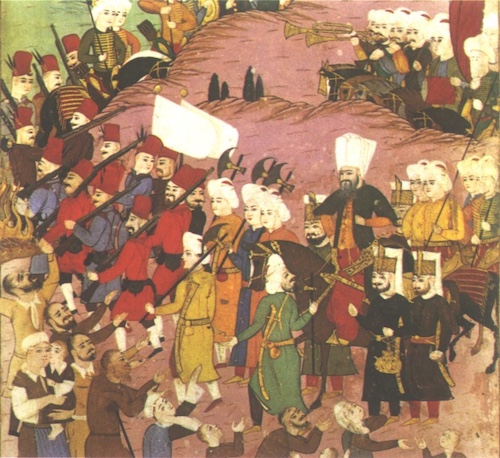During the 1500s and 1600s, the Ottoman Empire was one of the most powerful empires in the world. Centered in what is now Turkey, the empire controlled parts of southeastern Europe, North Africa, and the Middle East. At its height, it stretched from the borders of Persia to the gates of Vienna. Because of its size and strength, the Ottoman Empire played a major role in European politics—and its presence helped shape the decisions of European rulers.
Suleiman the Magnificent and Ottoman Power

One of the most famous leaders of the Ottoman Empire was Suleiman the Magnificent, who ruled from 1520 to 1566. He held the title of sultan, which meant he was both the political and religious leader of the empire. Sultans had total authority over the military, government, and law—similar to how absolute monarchs ruled in Europe.
Under Suleiman’s leadership, the empire expanded deep into central Europe, capturing large parts of Hungary and threatening the Austrian Habsburgs. His military campaigns brought the Ottomans to the edge of Vienna, the capital of the Holy Roman Empire.
European monarchs saw Suleiman’s power as a major threat. His strong army and centralized government forced many kings and queens to strengthen their own militaries and tighten control at home. This pressure often pushed European rulers toward absolutism, so they could respond quickly to outside threats and defend their borders.
The Balance of Power in Europe
The Ottoman Empire influenced not just military planning, but also alliances and diplomacy in Europe. Sometimes, Christian rulers made temporary alliances with the Ottomans to weaken their enemies. For example, France worked with the Ottomans to challenge the power of the Habsburgs. These partnerships showed that religion was not always the most important factor in European politics—power often came first.
Because of the Ottoman threat in the east, European rulers also spent more money on weapons, fortresses, and professional soldiers. Monarchs used this as a reason to collect more taxes and limit the power of nobles, helping them gain more absolute control.
The Rise of Russia and Conflicts in the East
As the Ottoman Empire pushed into eastern Europe, Russia also began expanding its territory. In the 1600s and 1700s, Russia and the Ottomans clashed over land in Eastern Europe and the Black Sea region. These conflicts would continue for centuries, shaping the way Russian czars thought about power and security.

To stand up to the Ottomans, Russian rulers like Peter the Great built larger armies and strengthened their governments. In this way, the Ottoman Empire influenced how Russian monarchs used absolutist ideas to protect their nation.
Why It Matters
The Ottoman Empire helped shape the political map of Europe. Its powerful army, expanding territory, and presence in central Europe forced European monarchs to respond with stronger leadership. Whether it was defending borders, raising armies, or creating alliances, the rise of absolutism in Europe was closely tied to the presence of the Ottoman Empire.
